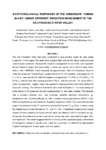Por favor, use este identificador para citar o enlazar este ítem:
http://www.alice.cnptia.embrapa.br/alice/handle/doc/160504Registro completo de metadatos
| Campo DC | Valor | Lengua/Idioma |
|---|---|---|
| dc.contributor.author | LIMA FILHO, J. M. | pt_BR |
| dc.contributor.author | COSTA, A. L. C. | pt_BR |
| dc.contributor.author | SOARES, J. M. | pt_BR |
| dc.contributor.author | PEREIRA, G. E. | pt_BR |
| dc.contributor.author | SANTOS, J. de O. | pt_BR |
| dc.contributor.author | ALENCAR, Y. C. L. de | pt_BR |
| dc.date.accessioned | 2011-04-10T11:11:11Z | pt_BR |
| dc.date.available | 2011-04-10T11:11:11Z | pt_BR |
| dc.date.created | 2008-01-29 | pt_BR |
| dc.date.issued | 2007 | pt_BR |
| dc.identifier.citation | In: CONGRESO LATINOAMERICANO DE VITICULTURA Y ENOLOGIA, 11., 2007, Mendonza. Seduciendo al concumidor de hoy. Mendonza: IVV: CLEIFRA: SECYT, 2007. | pt_BR |
| dc.identifier.uri | http://www.alice.cnptia.embrapa.br/alice/handle/doc/160504 | pt_BR |
| dc.description | The So Francisco Valley has been considered a new growing region for wine grapeproduction. In this region, the wines have a typical taste and are the unique ones producedunder tropical conditions. Because the irrigation management is one of the most importantfactors related to grape and wine quality, a study was carried out by the Embrapa Semirido,in the VINIBRASIL Farm vineyards, at Lagoa Grande, State of Pernambuco, Brazil inwhich the grapevine ¡§Chenin Blanc¡¨, grafted onto the IAC 572 rootstock, and spaced by 1,0m x 3,0 m, was submitted to different irrigation managements: T1) 75% Kc; T2) 50% Kc; T3)50 % Kc until 80 days after pruning and then 75% Kc until harvest and; T4) about 30% Kc(Farm management). Irrigation water was applied by dripping and the treatments initiated 45days after pruning. The effects of treatments were observed based on the ecophysiologicalperformance of the grapevine through measurements of leaf water potential (£Zl) obtainedwith a pressure chamber and gas exchange variables (stomatal conductance, gs;transpiration rate, E; photosynthesis, A), with a portable infrared gas analyzer (IRGA ¡V Licor6200) during flowering and maturation (August to September, 2006). The results showed thatgrapevines submitted to the T1 treatment presented the highest £Zl, gs, E and A values duringthe hottest hours of day followed by T3 and T2. The T4 treatment presented the lowestvalues on these variables but higher intrinsic water use efficiency (WUE) calculated as A/gs.At harvest, this treatment showed lower bunch number per plant and yield but higher oBrixand higher pH. The results suggest that the monitoring of the ecophysiological performanceof winegrapes during the growth cycle, might be a good tool to establish an appropriatedirrigation management toward grape and wine quality. | pt_BR |
| dc.format | 1 CD-ROM. | pt_BR |
| dc.language.iso | eng | eng |
| dc.rights | openAccess | eng |
| dc.subject | Videira | pt_BR |
| dc.title | Ecophysiological responses of the winegrape Chenin Blanc under different irrigation management in the São Francisco river valley. | pt_BR |
| dc.type | Resumo em anais e proceedings | pt_BR |
| dc.date.updated | 2014-10-09T11:11:11Z | pt_BR |
| dc.subject.thesagro | Fotossíntese | pt_BR |
| dc.subject.thesagro | Uva | pt_BR |
| riaa.ainfo.id | 160504 | pt_BR |
| riaa.ainfo.lastupdate | 2014-10-09 | pt_BR |
| dc.contributor.institution | José Moacir Pinheiro Lima Filho, CPATSA; André Luis Chaves Costa, Facepe; José Monteiro Soares, CPATSA; Giuliano Elias Pereira, CPATSA; Juliana de Oliveira Santos, CNPq; Yitzhak Coelho Lins de Alencar, Facepe. | pt_BR |
| Aparece en las colecciones: | Resumo em anais de congresso (CPATSA)  | |
Ficheros en este ítem:
| Fichero | Descripción | Tamaño | Formato | |
|---|---|---|---|---|
| OPB1678.pdf | 91.52 kB | Adobe PDF |  Visualizar/Abrir |









